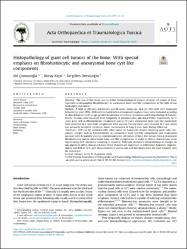| dc.contributor.author | Çomunoğlu, Nil | |
| dc.contributor.author | Kepil, Nuray | |
| dc.contributor.author | Dervişoğlu, Sergülen | |
| dc.date.accessioned | 10.07.201910:49:13 | |
| dc.date.accessioned | 2019-07-10T19:49:47Z | |
| dc.date.available | 10.07.201910:49:13 | |
| dc.date.available | 2019-07-10T19:49:47Z | |
| dc.date.issued | 2019 | en_US |
| dc.identifier.citation | Çomunoğlu, N., Kepil, N. ve Dervişoğlu, S. (2019). Histopathology of giant cell tumors of the bone: With special emphasis on fibrohistiocytic and aneurysmal bone cyst like components. Acta Orthopaedica et Traumatologica Turcica, 53(1), 35-39. https://dx.doi.org/10.1016/j.aott.2018.10.007 | en_US |
| dc.identifier.issn | 1017-995X | |
| dc.identifier.uri | https://dx.doi.org/10.1016/j.aott.2018.10.007 | |
| dc.identifier.uri | https://hdl.handle.net/20.500.12511/1765 | |
| dc.description | WOS: 000464719700007 | en_US |
| dc.description | PubMed ID: 30392920 | en_US |
| dc.description.abstract | Objective: The aim of this study was to define histopathological features of giant cell tumor of bone, especially accompanying fibrohistiocytic or aneurysmal bone cyst like components, in the light of our institutions experience. Methods: A total of 120 cases (64 females and 56 males; mean age: 36.2 (12-80)) with 'GCT' diagnosed between the years 1996-2016 were included in this retrospective analysis. Cases were evaluated according to clinical features such as age, gender, localization, recurrence, metastasis and histopathological features. Results: Tumors were localized most frequently at proximal tibia and distal femur, respectively. In 11 cases areas rich in fibrohistiocytic component and in 20 cases aneurysmal bone cyst like component were observed. In 2 cases both components were present. Twenty three cases recurred. In 1 case which was primarily located at calcaneus, tumor metastasized to lung 4 years later during follow-up. Conclusion: GCT can be confused with other tumor or tumor-like lesions involving giant cells. Secondary changes such as fibrohistiocytic or aneurysmal bone cyst-like components and coagulation necrosis were frequently seen in conventional giant cell tumor of bone. For tumors having prominent fibrohistiocytic and/or aneurysmal bone cyst-like components, in order to detect characteristic areas representing GCT, additional sampling is essential. Although secondary histopathological changes do not appear to affect clinical outcome, these features are important in differential diagnosis. Approximately one fifth of GCT cases show recurrence and sacrum and foot bones were the most frequent sites for recurrence. | en_US |
| dc.language.iso | eng | en_US |
| dc.publisher | Turkish Assoc Orthopaedics Traumatology | en_US |
| dc.rights | info:eu-repo/semantics/openAccess | en_US |
| dc.rights | Attribution-NonCommercial-NoDerivatives 4.0 International | * |
| dc.rights.uri | https://creativecommons.org/licenses/by-nc-nd/4.0/ | * |
| dc.subject | Giant Cell Tumor of Bone | en_US |
| dc.subject | Osteoclastoma | en_US |
| dc.subject | Bone Tumors | en_US |
| dc.subject | Pathology | en_US |
| dc.subject | Bone | en_US |
| dc.title | Histopathology of giant cell tumors of the bone: With special emphasis on fibrohistiocytic and aneurysmal bone cyst like components | en_US |
| dc.type | article | en_US |
| dc.relation.ispartof | Acta Orthopaedica et Traumatologica Turcica | en_US |
| dc.department | İstanbul Medipol Üniversitesi, Tıp Fakültesi, Cerrahi Tıp Bilimleri Bölümü, Tıbbi Patoloji Ana Bilim Dalı | en_US |
| dc.identifier.volume | 53 | en_US |
| dc.identifier.issue | 1 | en_US |
| dc.identifier.startpage | 35 | en_US |
| dc.identifier.endpage | 39 | en_US |
| dc.relation.publicationcategory | Makale - Uluslararası Hakemli Dergi - Kurum Öğretim Elemanı | en_US |
| dc.identifier.doi | 10.1016/j.aott.2018.10.007 | en_US |
| dc.identifier.wosquality | Q4 | en_US |
| dc.identifier.scopusquality | Q2 | en_US |



















